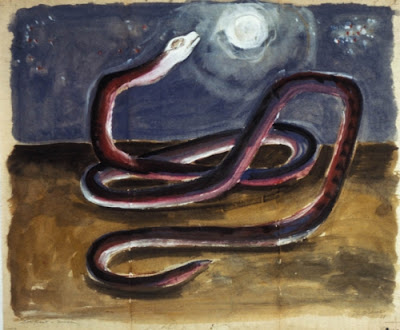After experimenting with poetry reading over breakfast rather than reading the newspaper to the benefit of my felt well-being, this week I have been studying paintings over the muesli. I began with Morris Graves.
The uplift has been the same, framing the day's mind not with images of the brokenness that haunts our newspapers but the hard sought for, and realized, wholeness of these images. Here are two characteristic images of lone animals, poised on edge of spaces: water for the bird, desert for the snake, the sky for both, reflective of energy and of contemplation.
It is a practice that does come with a sense of guilt, of ignoring 'reality' embedded in the 'news' and yet raises the simple question: which reality: the time bound flux of potential history or the symbolism of a different order?
Here the heart suggests against the preying mind starting with the essential - the wholeness from which one comes because it is only from there that a meaningful stance towards the temporal can emerge, framed by transcendence, to use a term of Graves' own.
It is not that one does not turn to the news: I cannot so easily surrender my prevailing addiction to 'knowing what is happening' (even as you suspect much of that sense is illusory) but why begin with it (and leave to it the framing word).
Such seeing as a starting point did Graves no harm, dying at a serene old age, with a body of work and delight that will last after much that passes for news has passed not into history but mere oblivion.
I love how the moon's light appears to be seeping down into the snake and the snake responds in dancing joy.


Comments
Post a Comment